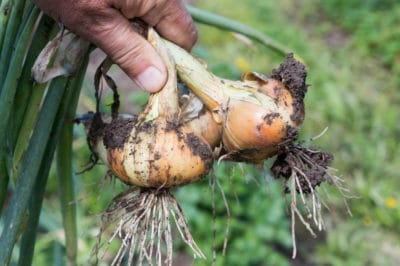How to Tell When Onions Are Ready for Harvest
As your onion bulbs grow larger, their flavor and scent gets stronger. Fully mature onions have the best flavor and storage life. Look for the following physical changes in your onion plants to know the optimal time for harvesting onions:
- Onion tops emerge from the soil
- Onion stalks start to turn yellow
- Onion stalks dry up and tip over
If your onions show these signs, it’s time to cure them.
How to Pick Onions
In order to cure your onions, you have to pull them out of the soil first. Onions are very durable, so you can pull them up by the dried stems or use a garden shovel to loosen the soil around them. Once you pull them from the soil, you can decide if you want to leave them in your garden to cure or move them to cure in an enclosed location.
How to Cure Onions
Curing onions is the process of drying them. You can either cure them is a well-ventilated, dry storage area, such as a garage or shed, or you can just leave them in your garden to dry. Onions usually take up to two weeks to dry out completely. If you dry them in your garden, keep an eye on the weather. You should gather them if there’s any rain in the forecast and place them in a protected area.
Follow these steps for curing your onions in a storage area:
- Spread the onions in a single layer on a dry surface.
- Dry the onions until the necks and stalks are completely dry.
- The outer skin of the bulb should feel like dried paper.
- Throw out any soft or damaged onions.
Climate for Storing Onions
It’s important to store your cured onions in the correct climate and storage container for the longest shelf life. The first item to consider is the temperature. Find a storage area that has a consistent temperature from 32°F (0°C) to 40°F (4.4°C). The humidity needed for onion storage is 65 to 70 percent. The storage area should also be dry with plenty of air circulation.
The following list of storage areas work out well for onions:
- Basement
- Garage
- Shed
- Unheated closet
- Vegetable closet
If the temperature drops below 32°F (0°C) in any of your storage areas, move the onions to a warmer area. Although onions can resist light frosts, freezing temperatures will damage them.
Storage Containers for Onions
When choosing containers for storing your onions, make sure the air can pass through them to prevent fungus growth and rot. You can get creative with your storage, recycling things like old nylon stockings, netted orange bags or old mesh laundry bags. As long as the onions stay dry, they’ll be fine. You can also use slatted boxes or baskets.
Prepare your onions for storing in a container by cutting the dried stems about 1 inch from the onion top. If you want to hang the onions for storage, braid the dried onion stems together and hang them from the garage or shed ceiling.
The storage life of your onions depends on the cultivar you planted and the storage conditions. For example, if you planted Red Zeppelin or Copra onions, they can last for several months, while varieties such as, Walla Walla or Sweet Spanish will only last a few weeks.
